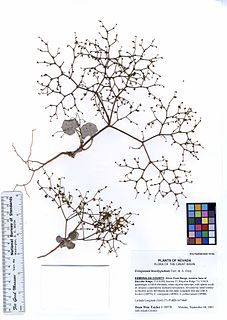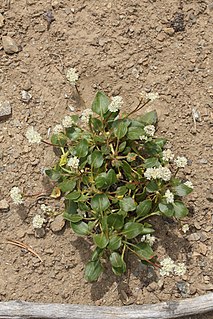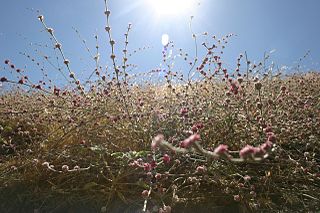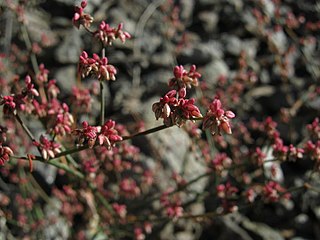
Eriogonum brachypodum is a species of wild buckwheat known by the common name Parry's buckwheat. This annual herb is native to the southwestern United States from California to Utah and especially the Mojave Desert. It grows in sandy and gravelly substrates. It has a skeletonlike spindly stem which branches many times. It can grow 5 to 50 centimeters in height and up to a meter in width. There is an array of rounded, dark-colored leaves around the base. Leaves are a few centimeters long and fuzzy on the undersides. Most of the plant is actually the spreading inflorescence. At intervals on the otherwise naked branches hang tiny clusters of glandular flowers a few millimeters wide in involucres of bell-shaped bracts. Each flower is less than three millimeters wide.

Eriogonum cinereum is a species of wild buckwheat known by the common names coastal buckwheat and ashyleaf buckwheat.

Eriogonum elatum is a species of wild buckwheat known by the common name tall woolly buckwheat. It is native to the western United States from California to Idaho. It is a perennial herb varying in size from one half to 1.5 meters in height. Its long leaves are located at the base of the plant and can be quite long for a buckwheat, over 20 centimeters in maximum length. The erect, branching stems are thin and naked and occasionally hollow. The plant produces small to large inflorescences with clusters of tiny flowers in shades of white to dark pink.

Eriogonum libertini is a species of wild buckwheat known by the common name Dubakella Mountain buckwheat. This uncommon plant is endemic to California where it grows in the rocky serpentine terrain of the southern Klamath Mountains and nearby ranges.

Eriogonum microthecum is a species of wild buckwheat known by the common name slender buckwheat. It is native to the western United States where it is found in a variety of habitats, particularly in dry areas such as deserts.

Eriogonum pyrolifolium is a species of wild buckwheat. It is native to western North America, from British Columbia to the high mountains of California.

Eriogonum roseum is a species of wild buckwheat known by the common name wand buckwheat. It is native to much of western California and the Sierra Nevada foothills, as well as parts of Oregon, and it is widespread and common in several plant communities.

Eriogonum wrightii is a species of wild buckwheat known by the common names bastardsage and Wright's buckwheat. It is native to the Southwestern United States, California, and northwest Mexico, where it grows in many plant communities, such as chaparral, in rocky habitats from mountains to deserts.

Eriogonum baileyi is a species of wild buckwheat that is commonly known as Bailey's buckwheat. It is native to the western United States, where it is a common member of the flora in several types of sandy habitat, such as desert and sagebrush. Eriogonum baileyi is an annual herb. It produces a spreading to erect, often wool-coated stem up to about half a meter tall. Leaves are woolly, round and located at the base of the plant. The inflorescence is a branching cyme bearing many clusters of flowers. The individual flowers are 1 to 2 millimeters wide and white or pink in color.

Eriogonum cithariforme is a species of wild buckwheat known by the common name cithara buckwheat.

Eriogonum congdonii is a species of wild buckwheat known by the common name Congdon's buckwheat. It is endemic to the Klamath Mountains of northern California, where it is an uncommon member of the serpentine soils flora in the local forests. It is a low, matting shrub growing up to about half a meter wide and tall. The woolly leaves are widely lance-shaped and are found along the stems, especially in clusters at the stem tips. The inflorescence is an erect, dense umbel of many tiny bright yellow flowers.
Eriogonum deserticola is a species of wild buckwheat known by the common name Colorado Desert buckwheat.

Eriogonum hoffmannii is a species of wild buckwheat known by the common name Hoffmann's buckwheat. It is endemic to Inyo County, California, where it is found only in the mountains around Death Valley; most of the known populations of the plant are located in Death Valley National Park. The plant grows in the desert scrub on the slopes of the Panamint, Black, and Funeral Mountains.
Eriogonum molestum is a species of wild buckwheat known by the common name pineland buckwheat. It is endemic to southern California, where it grows in the Transverse Ranges of Ventura County to the Peninsular Ranges of San Diego County.
Eriogonum pendulum is a rare species of wild buckwheat known by the common name Waldo buckwheat. It is endemic to the Klamath Mountains of Josephine County, Oregon, and Del Norte County, California, where it is a member of the serpentine soils flora.

Eriogonum prattenianum is a species of wild buckwheat known by the common name Nevada City buckwheat.

Eriogonum ternatum is a species of wild buckwheat known by the common name ternate buckwheat. It is native to mountain ranges of northern California and southern Oregon, where it grows in the serpentine soil of the forests. This is a perennial herb forming mats up to half a meter wide with rosetted clusters of oval to rounded woolly leaves each about a centimeter long. The inflorescence arises on a flowering stem and bears an umbel of bright yellow flowers.

Eriogonum tripodum is a rare species of wild buckwheat known by the common name tripod duckwheat. It is endemic to California, where it is known from the Sierra Nevada foothills and northern sections of the Coast Ranges.
Eriogonum cedrorum is a rare species of wild buckwheat known by the common name The Cedars buckwheat. It is endemic to Sonoma County, California where it is known only from The Cedars, an unincorporated area outside of Guerneville near Cazadero.

Eriogonum niveum is a species of flowering plant in the buckwheat family known by the common name snow buckwheat. It is native to the Pacific Northwest of North America, where it occurs in British Columbia, Washington, Oregon, and Idaho. It flowers late in the summer.
















